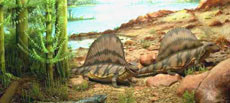 |
 |
 |
 |
 |
Produced
by the Population Genetics and Evolution class, Furman University |
||||
 |
 |
 |
 |
 |
Produced
by the Population Genetics and Evolution class, Furman University |
||||
 |
Protorosaurus
(and diapsid archosauromorphs) |
 |
||
| Protorosaurus
is an ancient reptilian genus belonging to the order Prolacertiformes.
This “first lizard” was first discovered in Germany, although
additional fossils have been found in Britain (Evans and King 1993). It
grew up to 2 meters in length, had a relatively long neck, and featured
an ambiguous series of cervical and dorsal vertebrae. It was most likely
semi-aquatic given its morphological considerations (Evans 1988). Protorosaurus
is also the earliest known member of the subclass Archosauromorpha, appearing
about 250 mya in the fossil record. It possesses several hallmark traits
of this subclass, such as two fenestrae on the sides of the skull (in
the front of the eyes and in the lower jaw), a tall, slender skull with
a tapered snout, teeth set in sockets, and a modified ankle joint. The
archosauromorphs are of particular evolutionary significance because they
include the dinosaurs, which ruled the terrestrial landscape for most
of the Mesozoic Era. Today, their extant descendents include birds and
crocodilians (UCMP 1995). So, Protorosaurus is the oldest fossil
of a dominant and diverse group.
Page by Robert Mazgaj |
 |
| Protorosaurus speneri. Photo from: Wikipedia.org | |
| Evans SE. 1988. The upper Permian reptile Adelosaurus from Durham. Paleontology 31: 957- 964. Evans SE, King MS. 1993. A new specimen of Protorosaurus (Reptilia: Diapsida) from the Marl Slate (late Permian) of Britain. Proceedings of the Yorkshire Geological Society 49: 229-234. Hutchinson J. 1995. The Great Archosaur Lineage. University of California Museum of Paleontology. Accessed 17 Mar. 2010. |